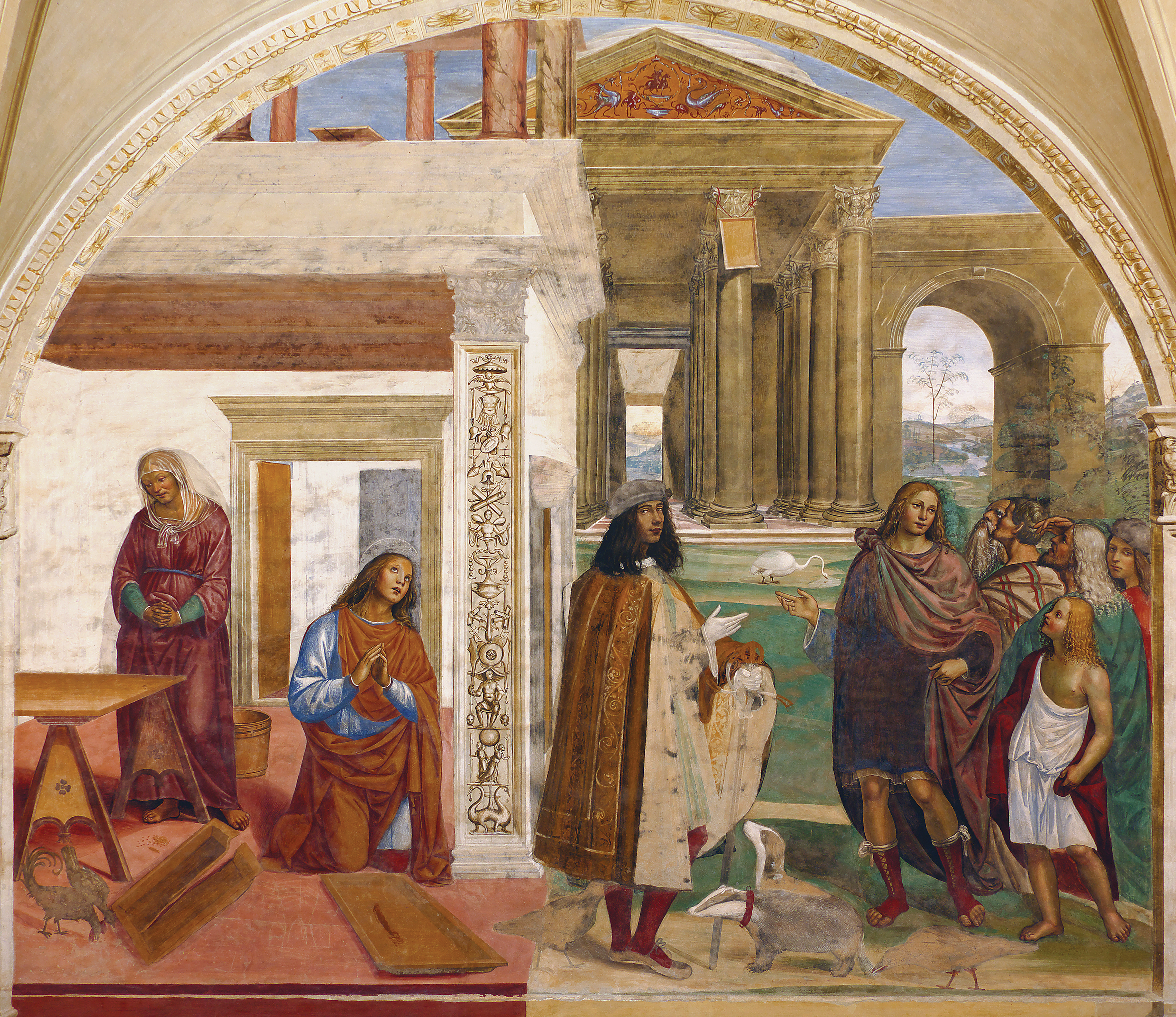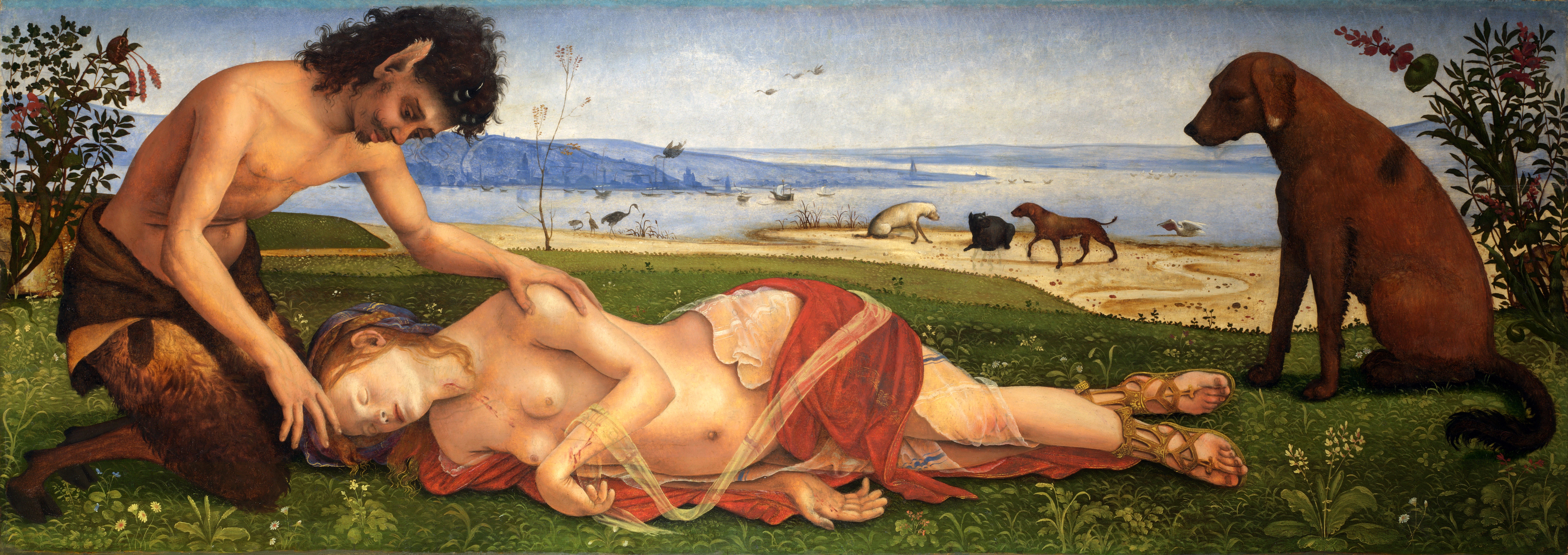|
Saint Paul Enthroned
''Saint Paul Enthroned'' is an oil on canvas painting by Domenico Beccafumi, now in the Museo dell'Opera del Duomo (Siena), Museo dell'Opera del Duomo in Siena. It is dated to c. 1515 due to its style, before his ''St Catherine of Siena Receiving the Stigmata'' and after his trip to Rome, where he had come into contact with Sodoma and Florentine artists of the period - the figure of the saint draws on the prophets in Michelangelo's Sistine Chapel ceiling whilst those in the background draw on Dürer and Piero di Cosimo. It was commissioned by the Corte degli Uffiziali di Mercanzia for the now-destroyed church of San Paolo in Siena. It was mentioned as a "tavoletta" (small canvas) "made by Domenico when he was young" in Vasari's ''Lives of the Artists'', though that author may not have seen the work himself and no document survives with direct references to the commission. A preparatory drawing for the figures of the Madonna and Child at the top survives in the Uffizi's Gabinetto de ... [...More Info...] [...Related Items...] OR: [Wikipedia] [Google] [Baidu] |
Domenico Beccafumi 066
Domenico is an Italian given name for males and may refer to: People * Domenico Alfani, Italian painter * Domenico Allegri, Italian composer * Domenico Alvaro, Italian mobster * Domenico Ambrogi, Italian painter * Domenico Auria, Italian architect * Domenico del Barbieri, Florentine artist * Domenico di Bartolo, Italian painter * Domenico Bartolucci, Italian Roman Catholic cardinal * Domenico di Pace Beccafumi, Italian painter * Domenico Pignatelli di Belmonte, Italian Roman Catholic cardinal * Domenico Berardi, Italian footballer * Domenico Bernini, son of Gian Lorenzo Bernini * Domenico Bidognetti, Italian criminal * Domenico Bollani, Venetian diplomat and politician * Domenico Canale, Italian-American distributor * Domenico Caprioli, Italian painter * Domenico Caruso, Italian poet and writer * Domenico Cefalù, Italian-American mobster * Domenico Cimarosa, Italian composer * Domenico Cirillo, Italian physician and patriot * Domenico Colombo, father of Christopher Columb ... [...More Info...] [...Related Items...] OR: [Wikipedia] [Google] [Baidu] |
Domenico Beccafumi
Domenico di Pace Beccafumi (1486May 18, 1551) was an Italian Renaissance-Mannerist painter active predominantly in Siena. He is considered one of the last undiluted representatives of the Sienese school of painting. Biography Domenico was born in Montaperti, near Siena, the son of Giacomo di Pace, a peasant who worked on the estate of Lorenzo Beccafumi. Seeing his talent for drawing, Lorenzo adopted him, and commended him to learn painting from Mechero, a lesser Sienese artist. In 1509 he traveled to Rome, where he learned from the artists who had just done their first work in the Vatican, but soon returned to Siena. However, while the Roman forays of two Sienese artists of roughly his generation (Il Sodoma and Peruzzi) had imbued them with elements of the Umbrian-Florentine Classical style, Beccafumi's style remains, in striking ways, provincial. In Siena, he painted religious pieces for churches and of mythological decorations for private patrons, only mildly influenced by the ... [...More Info...] [...Related Items...] OR: [Wikipedia] [Google] [Baidu] |
Museo Dell'Opera Del Duomo (Siena)
The Museo dell'Opera del Duomo is an art museum in Siena, in Tuscany in central Italy. It houses works of art and architectural fragments that were formerly in, or a part of, the Duomo of Siena (Siena Cathedral). These include a number of Italian Gothic sculptures by Giovanni Pisano and his school from the façade of the cathedral; the ''Maestà'' of Duccio di Boninsegna, which was the altarpiece from about 1311 until 1505 or 1506; and works by Ambrogio and Pietro Lorenzetti. There are also works moved to the museum from other churches in the area, such as the ''Madonna'' of Duccio brought from the at Crevole in the comune of Murlo Murlo is a ''comune'' (municipality) in the Province of Siena in the Italian region Tuscany, located about south of Florence and about south of Siena. Murlo borders the following municipalities: Buonconvento, Civitella Paganico, Montalcino, Mont .... References Art museums and galleries in Siena Art museums established in 1879 Religiou ... [...More Info...] [...Related Items...] OR: [Wikipedia] [Google] [Baidu] |
Siena
Siena ( , ; lat, Sena Iulia) is a city in Tuscany, Italy. It is the capital of the province of Siena. The city is historically linked to commercial and banking activities, having been a major banking center until the 13th and 14th centuries. Siena is also home to the oldest bank in the world, the Monte dei Paschi bank, which has been operating continuously since 1472. Several significant Renaissance painters worked and were born in Siena, among them Duccio, Ambrogio Lorenzetti, Simone Martini and Sassetta, and influenced the course of Italian and European art. The University of Siena, originally called ''Studium Senese'', was founded in 1240, making it one of the oldest universities in continuous operation in the world. Siena was one of the most important cities in medieval Europe, and its historic centre is a UNESCO World Heritage Site. From January until the end of September of 2021 it had about 217,000 arrivals, with the largest numbers of foreign visitors coming ... [...More Info...] [...Related Items...] OR: [Wikipedia] [Google] [Baidu] |
Sodoma
Il Sodoma (1477 – 14 February 1549) was the name given to the Italian Renaissance painter Giovanni Antonio Bazzi. Il Sodoma painted in a manner that superimposed the High Renaissance style of early 16th-century Rome onto the traditions of the provincial Sienese school; he spent the bulk of his professional life in Siena, with two periods in Rome. Biography Giovanni Bazzi was born in Vercelli, Piedmont, in 1477. His first master was the "archaic" Martino Spanzotti; he also appears to have been a student of the painter Giovenone. After acquiring the strong colouring and other distinctive stylistic features of the Lombard school and – though he is not known to have travelled to Milan – somehow absorbing the superficial mannerisms of Leonardo (Freedberg 1993:117), he travelled to Siena before 1503, perhaps at the behest of agents of the Spannocchi family, and began with fresco cycles for Olivetan monks and a series of small Ovidian ceiling panels and a frieze depicting t ... [...More Info...] [...Related Items...] OR: [Wikipedia] [Google] [Baidu] |
Sistine Chapel Ceiling
The Sistine Chapel ceiling ( it, Soffitto della Cappella Sistina), painted in fresco by Michelangelo between 1508 and 1512, is a cornerstone work of High Renaissance Renaissance art, art. The Sistine Chapel is the large papal chapel built within the Vatican City, Vatican between 1477 and 1480 by Pope Sixtus IV, for whom the chapel is named. The ceiling was painted at the commission of Pope Julius II. The ceiling's various painted elements form part of a larger scheme of decoration within the chapel. Prior to Michelangelo's contribution, the walls were painted by several leading artists of the late 15th century including Sandro Botticelli, Domenico Ghirlandaio, and Pietro Perugino. After the ceiling was painted, Raphael created Raphael Cartoons, a set of large tapestries (1515–1516) to cover the lower portion of the wall. Michelangelo returned to the chapel to create ''The Last Judgment (Michelangelo), The Last Judgment'', a large wall fresco situated behind the altar. Th ... [...More Info...] [...Related Items...] OR: [Wikipedia] [Google] [Baidu] |
Piero Di Cosimo
Piero di Cosimo (2 January 1462 – 12 April 1522), also known as Piero di Lorenzo, was an Italian painter of the Renaissance. He is most famous for the mythological and allegorical subjects he painted in the late Quattrocento; he is said to have abandoned these to return to religious subjects under the influence of Savonarola, the preacher who exercised a huge sway in Florence in the 1490s, and had a similar effect on Botticelli. The High Renaissance style of the new century had little influence on him, and he retained the straightforward realism of his figures, which combines with an often whimsical treatment of his subjects to create the distinctive mood of his works. Vasari has many stories of his eccentricity, and the mythological subjects have an individual and quirky fascination. He trained under Cosimo Rosselli, whose daughter he married, and assisted him in his Sistine Chapel frescos. He was also influenced by Early Netherlandish painting, and busy landscapes feat ... [...More Info...] [...Related Items...] OR: [Wikipedia] [Google] [Baidu] |
Lives Of The Artists
''The Lives of the Most Excellent Painters, Sculptors, and Architects'' ( it, Le vite de' più eccellenti pittori, scultori, e architettori), often simply known as ''The Lives'' ( it, Le Vite), is a series of artist biographies written by 16th-century Italian painter and architect Giorgio Vasari, which is considered "perhaps the most famous, and even today the most-read work of the older literature of art",Max Marmor, ''Kunstliteratur'' translated by , in Art Documentation Vol 11 # 1, 1992 "some of the 's most influential writing on ... [...More Info...] [...Related Items...] OR: [Wikipedia] [Google] [Baidu] |
Uffizi
The Uffizi Gallery (; it, Galleria degli Uffizi, italic=no, ) is a prominent art museum located adjacent to the Piazza della Signoria in the Historic Centre of Florence in the region of Tuscany, Italy. One of the most important Italian museums and the most visited, it is also one of the largest and best known in the world and holds a collection of priceless works, particularly from the period of the Italian Renaissance. After the ruling House of Medici died out, their art collections were given to the city of Florence under the famous ''Patto di famiglia'' negotiated by Anna Maria Luisa, the last Medici heiress. The Uffizi is one of the first modern museums. The gallery had been open to visitors by request since the sixteenth century, and in 1765 it was officially opened to the public, formally becoming a museum in 1865. History The building of the Uffizi complex was begun by Giorgio Vasari in 1560 for Cosimo I de' Medici so as to accommodate the offices of the Florentine ... [...More Info...] [...Related Items...] OR: [Wikipedia] [Google] [Baidu] |
Paintings In The Collection Of The Museo Dell'Opera Del Duomo (Siena)
Painting is the practice of applying paint, pigment, color or other medium to a solid surface (called the "matrix" or "support"). The medium is commonly applied to the base with a brush, but other implements, such as knives, sponges, and airbrushes, can be used. In art, the term ''painting ''describes both the act and the result of the action (the final work is called "a painting"). The support for paintings includes such surfaces as walls, paper, canvas, wood, glass, lacquer, pottery, leaf, copper and concrete, and the painting may incorporate multiple other materials, including sand, clay, paper, plaster, gold leaf, and even whole objects. Painting is an important form in the visual arts, bringing in elements such as drawing, composition, gesture (as in gestural painting), narration (as in narrative art), and abstraction (as in abstract art). Paintings can be naturalistic and representational (as in still life and landscape painting), photographic, abstract, nar ... [...More Info...] [...Related Items...] OR: [Wikipedia] [Google] [Baidu] |
Paintings Depicting Paul The Apostle
Painting is the practice of applying paint, pigment, color or other medium to a solid surface (called the "matrix" or "support"). The medium is commonly applied to the base with a brush, but other implements, such as knives, sponges, and airbrushes, can be used. In art, the term ''painting ''describes both the act and the result of the action (the final work is called "a painting"). The support for paintings includes such surfaces as walls, paper, canvas, wood, glass, lacquer, pottery, leaf, copper and concrete, and the painting may incorporate multiple other materials, including sand, clay, paper, plaster, gold leaf, and even whole objects. Painting is an important form in the visual arts, bringing in elements such as drawing, composition, gesture (as in gestural painting), narration (as in narrative art), and abstraction (as in abstract art). Paintings can be naturalistic and representational (as in still life and landscape painting), photographic, abstract, nar ... [...More Info...] [...Related Items...] OR: [Wikipedia] [Google] [Baidu] |







